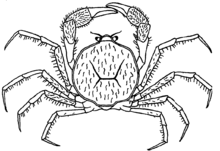Amarinus lacustris
| Amarinus lacustris | |
|---|---|
 | |
| Scientific classification | |
| Kingdom: | Animalia |
| Phylum: | Arthropoda |
| Subphylum: | Crustacea |
| Class: | Malacostraca |
| Order: | Decapoda |
| Infraorder: | Brachyura |
| Family: | Hymenosomatidae |
| Genus: | Amarinus |
| Species: | A. lacustris |
| Binomial name | |
| Amarinus lacustris (Chilton, 1882) | |
| Synonyms [1][2] | |
| |
Amarinus lacustris is a species of freshwater crab from Australia, New Zealand and nearby islands, where it lives in water of various salinities. It grows up to 10 mm (0.4 in) wide, with an H-shaped groove on its back. It is an omnivore and is eaten by crayfish and fish. It was first discovered in Lake Pupuke, near Auckland, and is the only freshwater crab in New Zealand.
Distribution
A. lacustris is widespread in south-eastern Australia, from Tasmania to the Murray-Darling basin in South Australia and Victoria.[3] It reaches as far inland as Lake Colac, Victoria.[4]
In New Zealand, A. lacustris is the only freshwater crab, and is found in a variety of habitats, including lakes, slow-flowing streams and larger rivers, including the lower reaches of the Waikato River.[5]
It is also found on small islands in the Tasman Sea, such as Lord Howe Island and Norfolk Island,[3] where it was first found at an altitude of "about 3,000 ft" (900 m) on Mount Gower.[2]
Description
A. lacustris grows to a maximum size of 10 millimetres (0.39 in) across the carapace.[5] The carapace is almost circular and has a set of grooves forming an H-shape, with the two uprights bending outwards, and the whole animal is covered in setae.[6]
The closely related species A. paralacustris was separated from A. lacustris in 1970,[3] but only mature females can be identified to the species level.[4] The main difference between the two is that A. lacustris has "direct development", in which there are no free-living larval stages, whereas A. paralacustris has indirect development, including free-swimming larvae.[7]
Ecology
A. lacustris lives in estuarine, freshwater and shallow subtidal habitats, usually in salinities of 1–6‰, but occasionally to 0.1–9.6‰.[3] Remains of both animals and plants have been found in the gut contents of A. lacustris, indicating an omnivorous diet.[6] Its predators include crayfish and introduced trout.[6]
Taxonomic history
| External identifiers for Amarinus lacustris | |
|---|---|
| WoRMS | 441731 |
| Also found in: Wikispecies | |
A. lacustris was first described (as Elamena lacustris) by Charles Chilton in 1882, based on a single juvenile female collected from Lake Pupuke on New Zealand's North Island.[8] The species was later transferred to the genus Hymenosoma,[2] and then to a new genus, Amarinus, in 1980.[1] The name amarinus is derived from the Latin meaning "not the sea", while the specific epithet lacustris means "of lakes".[9]
References
- 1 2 Peter K. L. Ng, Danièle Guinot & Peter J. F. Davie (2008). "Systema Brachyurorum: Part I. An annotated checklist of extant Brachyuran crabs of the world" (PDF). Raffles Bulletin of Zoology. 17: 1–286.
- 1 2 3 Charles Chilton (1914). "A fresh-water crab, and its distribution in Australia and New Zealand". Transactions and Proceedings of the Royal Society of New Zealand. 47: 316–320.
- 1 2 3 4 P. J. F. Davie (2002). "Hymenosomatidae". Zoological catalogue of Australia: Crustacea: Malocostraca: Eucarida (Part 2), Decapoda: Anomura, Brachyura. Volume 19 of Zoological catalogue of Australia, Australia. CSIRO Publishing / Bureau of Flora and Fauna. pp. 240–248. ISBN 978-0-643-05677-0.
- 1 2 Gary C. B. Poore & Shane T. Ahyong (2004). "Hymenosomatidae MacLeay, 1838". Marine decapod Crustacea of southern Australia: a guide to identification. CSIRO Publishing. pp. 390–397. ISBN 978-0-643-06906-0.
- 1 2 Clint McCullough. "Freshwater Crab (Hymenosomatidae: Amarinus lacustris)". New Zealand Native Freshwater Life. Retrieved June 4, 2010.
- 1 2 3 C. L. McLay (1988). "Brachyura and crab-like Anomura of New Zealand". Leigh Laboratory Bulletin. University of Auckland. 22: 1–463.
- ↑ J. S. Lucas (1970). "Breeding experiments to distinguish two sibling species of Halicarcinus (Crustacea, Brachyura)" (PDF). Journal of Zoology. 160: 267–278. doi:10.1111/j.1469-7998.1970.tb02905.x.
- ↑ Charles Chilton (1882). "Additions to the New Zealand Crustacea". Transactions and Proceedings of the New Zealand Institute. 14: 171–174.
- ↑ John Gooderham, Edward Tsyrlin (2002). "False spider crabs (Hymenosomatidae)". The waterbug book: a guide to the freshwater macroinvertebrates of temperate Australia. CSIRO Publishing. pp. 81–82. ISBN 978-0-643-06668-7.